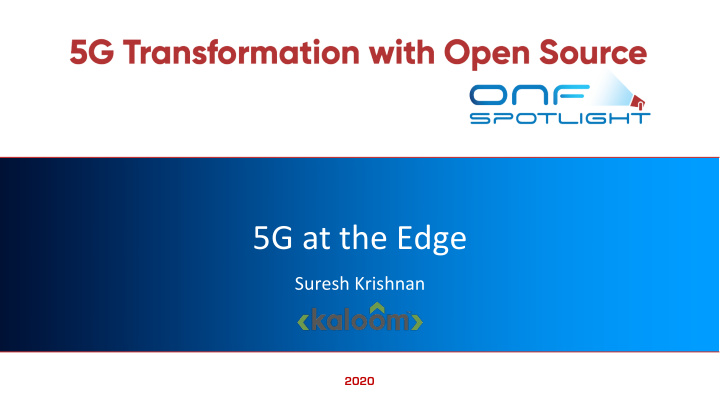



5G at the Edge Suresh Krishnan 2020
The facets of openness Open Software Open Open Hardware Interfaces
Open Software Military-Grade Rollback and Minimal Uniformity Security Upgrade Footprint ❏ ❏ ❏ Same software Linux leverages: Easily rollback to Lightweight OS orchestration a previous that provides ❏ SELinux ❏ cgroups model & version of the OS the flexible & ❏ Network namespaces ❏ management tools Deploy updates modular across networking, in a single step capabilities of compute, and Linux containers storage Standard off-the-shelf Linux
A Programmable Data Plane Add new features and services in runtime without • impacting traffic Allow developers to develop new code and drive • innovation Avoid vendor lock-in & eliminate the need to wait • for silicon upgrades Allow for customer programmability • Industry standard P4 programming language • Hardware Independence • 4
Open Hardware Run on open source hardware • Use open networking white box switches supporting OCP • reference models Avoid vendor lock-in • Use standardized tools for hardware management • ONIE • Redfish • 5
Open Interfaces Open Interfaces for configuration • Netconf, YANG • Open Interfaces towards orchestration • Openstack (ML2) • Kubernetes (CNI) • Open interfaces in 5G networks • N4 for Control-User Plane Separation • N3 towards RAN • N6 towards Data Networks • 6
Heterogeneous Hardware Strategy • We strongly believe in a heterogeneous hardware strategy and using the hardware best suited for the required characteristics • P4 is supported on heterogenous hardware including • Intel XEON CPUs • Programmable ASICs such as Barefoot Tofino • FPGAs (Stratix 10) and FPGA based SmartNICs from Intel • A heterogeneous dataplane can execute on any of these platforms including any combinations 7
5G Key points The newest generation of mobile network technologies Much higher throughputs than Multi Gigabit per second speeds have been 4G/LTE demonstrated Allows a lot of new applications – factory Much lower latency than 4G/LTE automation, AR/VR etc. Uses multiple frequencies/bands to Several of them are very high frequencies achieve high throughputs The downside of the high frequencies is much smaller coverage area
Market drivers Edge Computing “Around 10% of enterprise- generated data is created and processed outside a traditional centralized data center. By 2025, Gartner predicts this figure will reach 75%” Data is not centralized anymore Gartner: https://www.gartner.com/smarterwithgartner/what-edge-computing-means-for-infrastructure-and-operations-leaders/ CNCF: https://www.cncf.io/blog/2018/08/29/cncf-survey-use-of-cloud-native-technologies-in-production-has-grown-over-200-percent/ Gartner: https://www.gartner.com/en/newsroom/press-releases/2019-08-22-gartner-forecasts-worldwide-5g-network-infrastructure
Edge internet economy – applications and services for which our customers are building Edge networks $4,500 Applications & Services Connectivity $4,000 Platform Hardware $3,500 $3,000 Billions $2,500 $2,000 $1,500 $1,000 $500 $- 2019 2020 2021 2022 2023 2024 2025 2026 2027 2028 2029 2030 Source: Chetan Sharma Consulting, 2019
What is driving the edge? Requirements • Virtual Reality • Improve Application • Augmented Reality Availability • Industrial Robot • Bandwidth & Connectivity • Industrial Control • Security • Connected Cars • Less than 10ms latency • Interactive Gaming • Ability to scale • Remote Medicine • Reduced TCO Public cloud only (AWS, Azure, Google etc.) not suited for low latency apps Measured from AWS: 21 ms (Northern Virginia) o Downtown New- Azure: 24 ms (Northern Virginia) o York over 10 Gbps link
Everybody wants to rule the edge
5G Slicing at the Edge RAN 5G Core Edge vFabrics Internet Content 5GCore Delivery Video Streaming UPF-C Mobile Radio Resource Control 5GCore Mobile Broadband Network Physical Layer Operator UPF-C Remote 5GCore Maintenance Connected Cars Cloud UPF-C Robotics 5GCore Control Industrial Control UPF-C
What is special about the edge? Power Space Latency There is limited amount of power There are significant space Several edge focused available for edge computing constraints at edge locations applications have low latency applications requirements
How to optimize the edge? Unify the Compute and the Networking (and potentially Storage) Unify • Eliminate duplicate functions • Enable considerable scale down Integrate Integrate Access Termination • Mobile and/or fixed accesses Reduce Reduce overall complexity Save Save costs Provide Provide workload orchestration
Programmability matters Promotes feature velocity • There is a huge time lag between widespread acceptance of a • protocol and its appearance in networking silicon Reduces/ eliminates vendor lock-in • No need to wait for a given vendor to provide a new chip or a • new appliance React quickly to protocol changes and fixes • Over The Air updates just like compute • Enables convergence •
Optimized Edge
Thank You! 2020
Recommend
More recommend